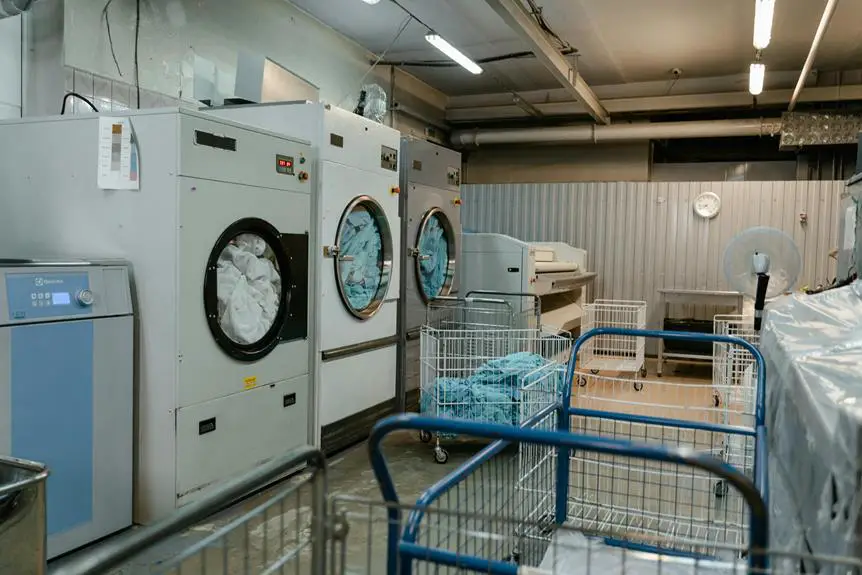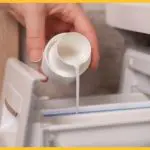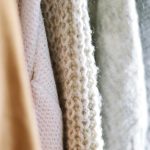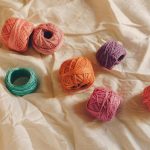When you're looking to enhance your laundry routine, using wool dryer balls with fabric softener can be a smart choice. By adding a few dryer balls to your load, you not only improve air circulation but also cut down on drying time. If you prefer liquid fabric softener, it's best to dilute it before applying it to the dryer balls. This simple step can make a noticeable difference, but there are other factors to consider that could further elevate your laundry experience. Curious about the best combinations or common pitfalls?
Table of Contents
Key Takeaways
- Add 3-6 wool dryer balls to the dryer to improve air circulation and reduce drying time.
- For liquid fabric softener, dilute it with water and mist onto the dryer balls before use.
- Combine dryer sheets with wool balls for added softness and fragrance during drying.
- Experiment with different combinations of dryer balls and fabric softeners for customized laundry results.
Benefits of Wool Dryer Balls
Using wool dryer balls can significantly reduce drying time while softening your laundry naturally. When you toss these balls into the dryer, they create separation between your clothes, allowing hot air to circulate more efficiently. This means your laundry dries faster, saving you time and energy.
In addition to reducing drying time, wool dryer balls help to minimize static cling. They work by absorbing moisture and releasing it back into the dryer, which helps keep your clothes from sticking together. You'll notice fewer wrinkles and fresher-smelling laundry without the need for chemical-laden fabric softeners.
Another benefit is their eco-friendliness. Wool dryer balls are reusable and last for hundreds of loads, making them a sustainable alternative to disposable dryer sheets. You can even add a few drops of essential oils to the balls for a natural fragrance, personalizing your laundry experience without harmful chemicals.
Choosing the Right Fabric Softener
Selecting the right fabric softener can enhance your laundry routine, making clothes feel softer and smell fresher. With so many options available, you'll want to consider a few factors before making your choice. Think about your family's needs, any allergies, and the scents you prefer.
Here's a quick comparison table to help you decide:
| Fabric Softener Type | Benefits |
|---|---|
| Liquid | Easy to use, versatile |
| Dryer Sheets | Convenient, no mess |
| Pods | Pre-measured, less waste |
| Natural/Organic | Eco-friendly, chemical-free |
Liquid softeners are great for standard use, while dryer sheets are perfect for on-the-go solutions. If you want to minimize waste, pods are your best bet. For those who prioritize eco-friendliness, look for natural or organic options.
Ultimately, your choice should align with your laundry goals. Don't forget to read labels and choose a product that complements the wool dryer balls you're using for optimal results!
How to Combine Both Products
To get the most out of your laundry routine, combine wool dryer balls with your chosen fabric softener for added softness and freshness.
Start by adding a few wool dryer balls to your dryer—typically, three to six balls work well depending on the load size. These balls help separate your clothes, increasing air circulation and reducing drying time.
Next, to incorporate fabric softener, you have a couple of options. If you're using liquid fabric softener, dilute it with some water in a spray bottle. Lightly mist the wool dryer balls with the mixture before tossing them into the dryer. This method ensures even distribution of the softener throughout the load.
Alternatively, if you prefer dryer sheets, you can still use them alongside the wool balls. Simply toss a dryer sheet into the dryer along with the balls. This combination will enhance the softness while also infusing your laundry with your favorite scent.
Tips for Optimal Use
Maximizing the effectiveness of wool dryer balls involves choosing the right number and ensuring they're clean and dry before each use. Typically, using 3-6 balls per load is ideal for optimal results. You can also experiment with the number based on your dryer capacity and the size of your load.
Here are some tips to enhance your experience:
| Tip | Description | Benefits |
|---|---|---|
| Use 3-6 Balls | Adjust based on load size | Improved drying efficiency |
| Clean Regularly | Wash balls every few weeks | Prevents lint buildup |
| Add Essential Oils | Apply a few drops before drying | Infuses fresh scents |
| Separate Fabrics | Mix heavier and lighter items | Ensures even drying |
| Monitor Drying Time | Check on progress, adjust as needed | Saves energy and time |
Common Misconceptions
Many people mistakenly believe that wool dryer balls are only effective for reducing drying time, but they actually offer a range of benefits beyond just speeding up the process. For instance, they help to soften fabrics naturally, which means you mightn't need as much, or any, fabric softener. This can save you money and reduce the chemicals in your laundry routine.
Another common misconception is that wool dryer balls will leave lint or residue on clothes. In reality, they're designed to be lint-free and shouldn't leave any marks on your garments when used correctly. You might also think that using too many dryer balls will create excessive noise, but most users find that the sound is minimal and not disruptive.
Some folks worry that dryer balls won't work well with heavier items like towels or blankets. However, they can be surprisingly effective, even with bulkier loads.
Lastly, it's important to note that while wool dryer balls are great, they're not necessarily a complete substitute for fabric softeners if you enjoy that fresh scent. Just remember, combining them with fabric softener can enhance your laundry experience.
Eco-Friendly Considerations
Using wool dryer balls is a smart choice for those looking to reduce their environmental impact while doing laundry. Unlike traditional dryer sheets and fabric softeners, which often contain synthetic chemicals and fragrances, wool dryer balls are made from natural fibers. This means they contribute less to landfill waste and don't introduce harmful substances into your home.
When you use wool dryer balls, you not only decrease your reliance on single-use products, but you also save energy. The balls help to separate clothes in the dryer, allowing hot air to circulate more efficiently. This can reduce drying time by up to 25%, which means less energy consumption and lower utility bills.
If you choose to use fabric softener alongside your wool dryer balls, consider eco-friendly options. Look for brands that are biodegradable and free from harsh chemicals. By combining wool dryer balls with natural fabric softeners, you'll enhance your laundry's freshness without compromising your eco-friendly values.
Incorporating these practices into your laundry routine makes a significant difference, and you'll feel good knowing you're making a positive choice for the environment.
Frequently Asked Questions
Can I Use Wool Dryer Balls With Any Type of Fabric Softener?
You can use wool dryer balls with most fabric softeners, but it's best to check the specific product instructions. Some fabric softeners might not work well with wool, affecting their performance and your laundry's softness.
How Many Wool Dryer Balls Should I Use per Load?
You should use three to four wool dryer balls per load. This helps improve drying efficiency, reduces wrinkles, and keeps your laundry soft. Adjust the number based on the size of your load for optimal results.
Do Wool Dryer Balls Reduce Drying Time?
Yes, wool dryer balls do reduce drying time. They circulate effectively, separating clothes and allowing hot air to flow more freely, which speeds up the drying process and helps you save energy and time.
Are There Any Fabrics That Shouldn't Be Used With Wool Dryer Balls?
You shouldn't use wool dryer balls with delicate fabrics like silk or lace, as they can cause snagging or damage. Always check care labels to ensure your fabrics are compatible for safe drying with dryer balls.
How Do I Clean My Wool Dryer Balls?
To clean your wool dryer balls, simply hand wash them with mild soap and warm water. Rinse thoroughly and let them air dry. Avoid using harsh chemicals to maintain their effectiveness and longevity.
- Tetron Fabric for Marine Applications: Durability and Use Cases - June 18, 2025
- Tetron Fabric for Outdoor Furniture: Weather Resistance and Care - June 18, 2025
- Tetron Fabric for Wall Coverings: Style and Application Tips - June 18, 2025







